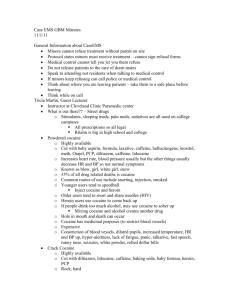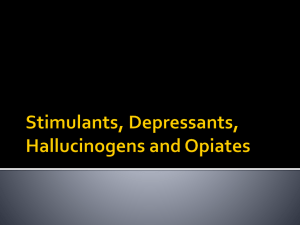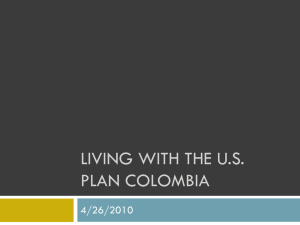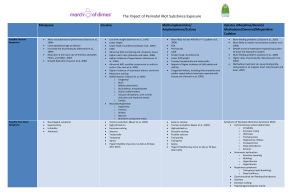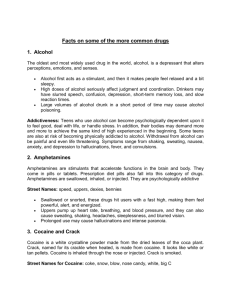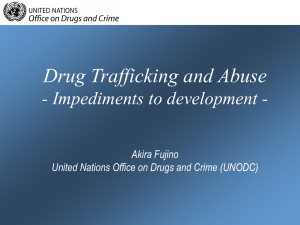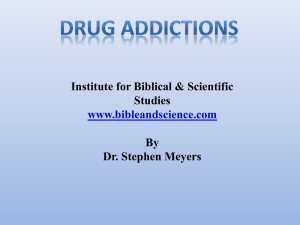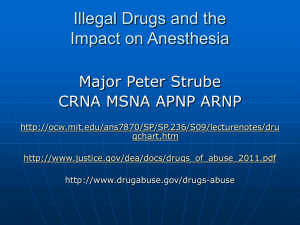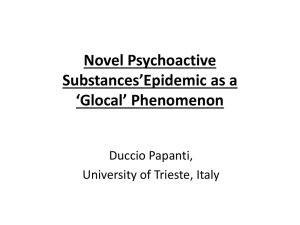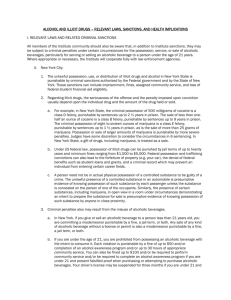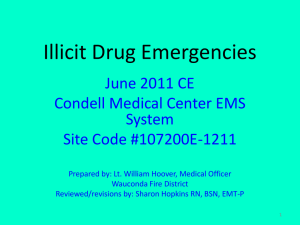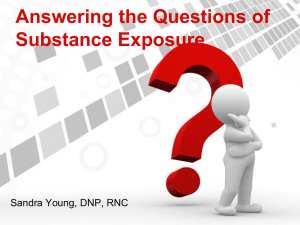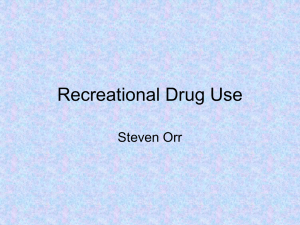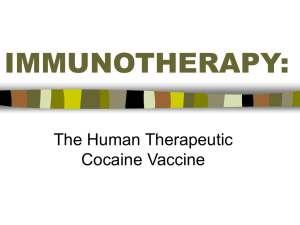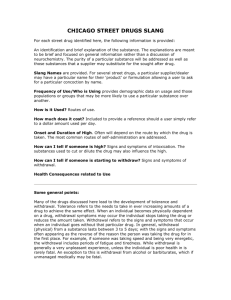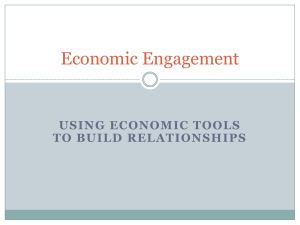Any Illicit Drug
advertisement
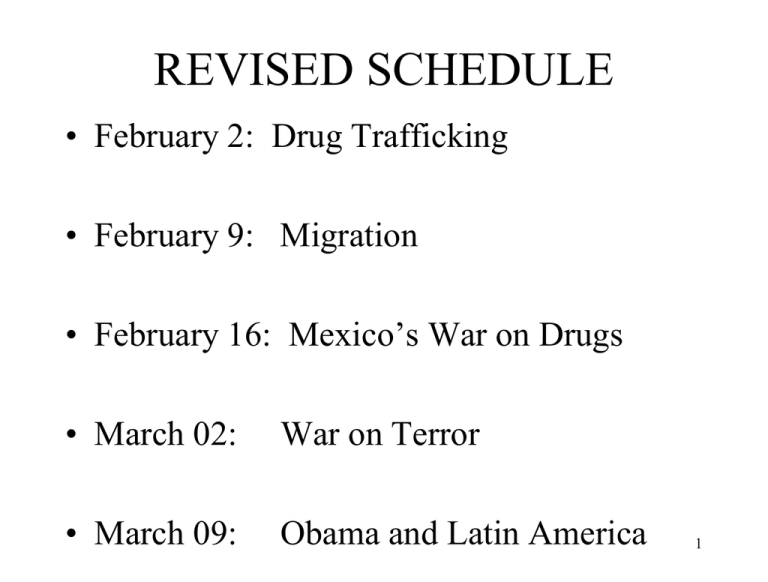
REVISED SCHEDULE • February 2: Drug Trafficking • February 9: Migration • February 16: Mexico’s War on Drugs • March 02: War on Terror • March 09: Obama and Latin America 1 PAPER ASSIGNMENT • Topic: Any subject related to U.S.-Latin American relations (whether or not covered in class)—proposed by student and approved by TA • Examples: Sports (e.g. baseball), film (depictions of Latina women), music (lyrics, popularity of stars, etc.), advertising (Corona beer) • In-class examples: Content of Latin American nationalism, impacts of drug war (e.g., Plan Colombia or Plan Mérida), reactions to 9/11, Bush/Obama relationship with Latin leaders, Hugo Chávez phenomenon, evaluations of NAFTA • Length: 8-12 double-spaced pages (plus notes or bibliography) • Due: Wednesday, March 2 2 FORMAT FOR PAPER • Introduce topic (and its importance) • Present a central question • Describe sources and methods (how will you answer your question?) • Analyze information and data • Conclusion: – Respond to your central question(s) – Suggest avenues for further research (optional) 3 THE POLITICAL ECONOMY OF DRUG TRAFFICKING INTRODUCTION 1. 2. 3. 4. Pervasiveness of issue Typicality? Or an extreme case? Categorizing “illicit drugs”— • Marijuana • Heroin • Cocaine • Designer drugs Note: Dangerous prescription drugs 4 READING • Smith, Talons, ch. 8 [review] • CR Selection 5: Astorga and Shirk, “Drug Trafficking Organizations and Counter-Drug Strategies” • DFC, Contemporary, chs. 2 and 9 (Mexico + Colombia) 5 OUTLINE • • • • • • The Global Market The Structure of Profits Patterns in U.S, Consumption U.S. Policy: The Drug Wars Implications for Latin America Drug Wars in Mexico • Questions of Public Policy: What Are the Alternatives? 6 THE GLOBAL MARKET: STRUCTURE AND SCALE 1. Worldwide flows, variations by drug 2. Consumption around the world 3. Roles for Latin America: the rise of “cartels” 4. The U.S. market: magnitudes, profits and costs 7 Global Production and Trafficking MDMA 1000 Cocaine 800 Bolivia 600 Peru 400 Colombia 200 0 1996 1997 1998 1999 2000 Potential Opium Production (mt) Potential Cocaine Production (mt) Amphetamine Type Stimulants 6000 Heroin 5000 4000 Mexico Colombia SE Asia SWAsia 3000 2000 1000 0 1996 1997 1998 1999 2000 8 Sources of Heroin Metric Tons 6,000 Colombia 5,106 5,000 5,000 3,441 3,389 Mexico 4,452 4,263 4,068 4,000 5,082 Pakistan 3,671 Thailand 3,302 3,000 Vietnam 2,000 Laos 1,264 1,000 Afghanistan Burma 0 91 ONDCP/FEB02 92 93 94 95 96 97 98 99 * Values for Latin America are projected 00 01* Users of Heroin by World Region Number of people (in millions) 10 9 8 7 6 5 4 3 2 1 0 Americas Europe Asia Africa Oceania Total Region 10 Estimated Cocaine Flows 3 percent Direct to U.S. 43 percent Caribbean Corridor 54 percent Mexico/Central American Corridor 11 Users of Cocaine by World Region Number of people (in millions) 16 14 12 10 8 6 4 2 0 North America South America Europe Asia Africa Oceania Total Region 12 Perspectives on Cocaine Worldwide Consumption Increasing 1990 = 500 MT 2000 = 600 MT U.S. Portion of Worldwide Consumption Declining 1990 = 400 MT 2000 = 300 MT All coca grown in the Andean Region 13 Cocaine Flows to Non-U.S. Markets CANADA 7% EUROPE 92% ASIA < 1% AFRICA < 1% ONDCP/FEB02 14 Who Are the Winners…? • • Where are the profits? Price structure of one kilo of pure cocaine, mid-1990s: Coca leaf (e.g., farmgate in Peru) Export of finished product (Colombia) Import of finished product (Miami) $20,500 Wholesale by kilo (in Chicago) Wholesale in one-ounce packets (Chicago) Final retail value (Chicago) $ 370 $1,200 $31,000 $62,000 $ 148,000 15 Trends in Drug Consumption, 1985-2000 Percent Reporting Past Month Use of Any Illicit Drug 15 New survey series* 10 5 *The survey methodology was changed in 1999. Estimates based on the new survey series are not comparable to previous years. 0 1985 1988 1990 1991 1992 1993 1994 1995 1996 1997 1998 1999 2000 Source: SAMHSA, National Household Survey on Drug Abuse. 16 Current Usage by Drug, 2000 Past Month Users (in Millions) Any Illicit Drug 14 Marijuana 10.7 Cocaine (incl. crack) Crack 1.2 0.265 Hallucinogens 0.97 Inhalants 0.62 LSD 0.4 Heroin 0.13 Nonmedical Use (any psychotherapeutic) 3.8 0 2 4 6 8 10 12 Source: 2000 National Household Survey on Drug Abuse 14 16 17 U.S. DRUG USERS • 2000 = 14.0 million (6.3%) • 2004 = 19.1 million (7.9%) • 2007 = 19.9 million (̴ 8%) 18 Usage of Marijuana Percent Reporting Past Month Use of Illicit Drugs, 2000 Only a drug other than marijuana 24% Marijuana 17% and some other drug 59% Marijuan a only 19 Source: 2000 National Household Survey on Drug Abuse Drug Abuse by Age Cohort Percent Reporting Past Month Use of an Illicit Drug 25 Prime example of an aging cohort of drug users -- this group began use in 1970s. 19.6 20 16.4 15 13.2 9.8 10 7.8 7 5.3 5 6.5 3 4.8 2.4 0.3 0 12-13 14-15 16-17 18-20 21-25 26-29 30-34 35-39 40-44 45-49 50-64 Years of age Source: 2000 National Household Survey on Drug Abuse 65+ 20 Drug usage among High-School Seniors Percent Reporting Use of “Any Illicit Drug” 25.7 12th 41.4 53.9 30-Day Annual Lifetime 22.7 10th 37.2 45.6 11.7 8th 19.5 26.8 0 10 20 30 40 Source: Monitoring the Future Study 50 60 21 Consumer Expenditures on Illicit Drugs, 2000 U.S. Users Spend $63.2 Billion Annually Billions of Dollars (Projections for 1999) 45.0 40.0 37.1 Source: ONDCP Paper, What America’s Users Spend on Illegal Drugs 35.0 30.0 25.0 20.0 11.9 15.0 10.4 10.0 5.0 1.6 2.3 Meth Other 0.0 Cocaine Heroin Marijuana 22 Economic Costs of Drug Abuse $160 Dollars, in Billions $140 $120 $100 $80 $143.4 $60 $40 $20 $44.1 $58.3 $102.2 $109.8 1992 1995 $66.9 $0 1985 1988 1990 1998 23 Source: Office of National Drug Control Policy, 2001. Calculation of Economic Costs of Drug Abuse (Billions of dollars) $12.9 $32.1 Health Care Lost Earnings $98.5 Other Impacts 24 Source: Office of National Drug Control Policy, 2001. U.S. POLICY: THE DRUG WARS 1. Participants and processes 2. Strategic content: • Goal: Reduce illegal drug use and availability • Enforcement > education, treatment, thus 2:1 ratio in federal budget • Supply control > demand reduction, thus interdiction and eradication • Assumption: One policy fits all…. • Criteria for evaluation 25 Federal Expenditures on Drug Control, 1980-2000 $14.4 $13.0 $12.0 $11.9 $11.6 $19.2 $18.8 $18.1 $4.6 $2.8 $2.7 $1.9 $1.6 $1.5 5 $2.3 $4.7 $6.5 10 $10.7 All Other Year: Actual Expenditures $9.6 15 $13.0 FY 2002: Enacted Level $17.8 FY 2003: President’s Request $15.2 20 $17.1 Dollars, in Billions 81 82 83 84 85 86 87 88 89 90 91 92 93 94 95 96 97 98 99 2000 2001 2002 2003 0 26 Composition of Federal Expenditures, 2000 Dollars, in Billions Fiscal Year 1986 -2003 20 15 Interdiction International Domestic Law Enforcement Demand Reduction 10 5 FY 02 FY 00 FY 98 FY 96 FY 94 FY 92 FY 90 FY 88 FY 86 0 27 COCAINE SEIZED (MT) Challenges to Interdiction 250 ARRIVAL ZONE 200 3% direct 150 100 TRANSIT ZONE 21% 10% 50 0 1996 1997 Source Zone 1990 1998 Transit Zone 1999 2000 CHANGES IN THREAT • World consumption dominated by US •Transit movement via aircraft •Cultivation primarily from Peru and Bolivia ONDCP/FEB02 16% Arrival Zone 2000 50% • Increasing European consumption •Transit movement via maritime vessels •Cultivation primarily from Colombia SOURCE: Annual Interagency Assessment of Cocaine Movement, April 2001 SOURCE ZONE 28 Interdiction of Cocaine, 1999 75 METRIC TONS DETECTED DEPARTING FOR NON-US MARKETS 512 Metric Tons Depart South America for U.S. 54% 277 MT 43% 220 MT 3% 15 MT Transit Zone Arrival Zone Seizures Seizures MEXICO / CENTRAL AMERICAN CORRIDOR CARIBBEAN CORRIDOR DIRECT TO CONTINENTAL U.S. -60 MT -14 MT -37 MT -7 MT 382 MT Potentially Arrives in the U.S. -12 MT 29 U.S. Prison Population, 1985-2000 Federal Prisons 145,416 Number of Inmates, in Millions 2,100 1,750 Local Jails 621,149 1,400 1,050 700 State Prisons 1,236,476 350 0 1985 1987 1989 1991 1993 1995 1997 Source: Bureau of Justice Statistics, 2001 1998 1999 30 2000 Imprisonment of Drug Offenders, 1980-2000 68,360 Drug Offenders in Federal Prison in 1999 300,000 250,000 200,000 150,000 100,000 251,200 Drug Offenders in State Prisons in 1999 50,000 0 80 81 82 83 84 85 86 87 88 89 90 91 92 Source: Bureau of Justice Statistics 93 94 95 96 97 98 99 31 Reasons for Drug Arrests, 2000 Arrests for Drug Abuse Violations, 2000 15.8% 9.3% 5.6% 4.1% Sale/Manufacture Heroin/Cocaine Sale/Manufacture Marijuana Sale/Manufacture Other Drugs Possession Marijuana 24.2% 40.9% Source: Uniform Crime Reports, FBI. Possession Heroin/Cocaine Possession other Dangerous Drugs 32 IMPLICATIONS FOR LATIN AMERICA 1. 2. 3. 4. 5. 6. 7. Economic costs and benefits Violence (and “drug wars” in multiple forms) Corruption Growth in consumption Threats to governability Challenges to sovereignty—e.g., invasion of Panama 1989 Process of “certification” (now modified) 33 34 35 QUESTIONS OF PUBLIC POLICY: WHAT ARE THE ALTERNATIVES? INTRODUCTION 1. What might be desirable? Or feasible? 2. What are the prospects? 36 ARE THERE ALTERNATIVES? 1. Continuation (or acceleration) of current policy: Increased budgets Establish coherence Long-term durability 37 2. Legalization: Regulation, not legalization Decriminalization? Partial or complete? 38 3. Changing priorities: Demand reduction > law enforcement Law enforcement = more on money laundering, less on retail pushers Focus on governability as key issue in Latin America Multilateral efforts against consumption and demand, rather than supply What about certification? 39 Availability of Treatment Percent of Population 12 or Older 7 6.3 6 5 4 3 2 1.2 0.6 1 0 Current Drug User . Drug Dependent Received Treatment 40 41 42 Costs and Benefits of Drug Treatment $15,000 $13,902 Cost Benefit $12,000 $9,000 $7,954 $7,630 $5,259 $6,000 $4,160 $3,813 $3,000 $2,895 $2,051 $2,575 $2,547 $0 Ambulatory Outpatient Long-Term Residential Short-Term Residential Outpatient Methadone Short-Term Hospital 43 Source: CSAT, National Evaluation Data Services Report ENLIGHTENMENT IN LATIN AMERICA! • Marijuana personal use is decriminalized in : – – – – – – – – Argentina Brazil (depenalized) Colombia Costa Rica Mexico Peru Uruguay Venezuela 44 AND NOW, THE WAR ON TERRORISM… 45

